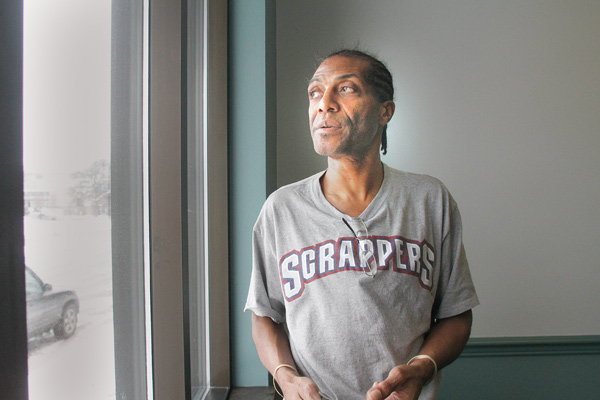Counting homeless vets

Keith Lomax of Youngstown, a Navy veteran, reflects on 2012, the year he was homeless and lived in an abandoned structure.
By WILLIAM K. ALCORN
alcorn@vindy.com
YOUNGSTOWN
Army veteran Todd Thornton has been living on the streets for some 18 of his 47 years.
“Life got in the way,” said Thornton, of Youngstown, explaining why he ended up homeless.
He was among five or six military veterans identified as homeless who attended a Warming Center event Tuesday at the United Methodist Community Center to ensure that homeless veterans were included in the 2015 Point in Time/Housing Inventory Count data collection survey for the Mahoning County Continuum of Care program.
The count started at sundown Tuesday and continued to sunrise today.
About 25 veterans filled out questionnaires to determine if they should be included in the count. The U.S. Department of Housing and Urban Development requires the PIT/HIC count to help determine funding for the county’s homeless programs.
Thornton, who served in the Army from 1990 to 1992, said events “kind of made me crazy,” which led to depression and getting into trouble with the law.
“My hope is that I can undo the damage I’ve done to myself and others,” Thornton said. “I’m almost 50, and I don’t have anything to show for it. I want a home that my four kids can come to. My one goal is to be normal. I’m tired of being a menace.”
Keith Lomax, 57, who served in the Navy in 1985-86 and was honorably discharged early because of severe sea sickness, thanked his sister’s generosity for getting him off the street.
He said he was homeless in 2012 living with a girlfriend in an abandoned house, something that eventually landed him in jail. A bicycle accident in 2012 left him temporarily paralyzed.
“But, because I had a felony on my record, I couldn’t get a place to stay,” Lomax said.
Today he has a home and is receiving Social Security disability because of injuries suffered in the bicycle accident. He is no longer homeless.
“Being homeless is not a picnic. I wouldn’t want to be homeless again, but it was an experience I’m glad I had,” he said.
“God has shown me he never strayed from me. It was me who strayed from him,” Lomax said.
The 2015 PIT/HIC count consisted of volunteer “sweepers” who went to places known to have homeless people, said Angie D. Paramore, director of the Mahoning County Continuum of Care.
Training sessions were conducted for volunteers, of which there were about 20, and agency-funded employees. Volunteers had a time frame to go out and “street sweep,” looking for unsheltered people with whom to conduct interviews and get data to give to HUD, she said.
The count also includes events before the beginning of the official count, such as the one at UMCC and agencies or organizations that conducted breakfast feedings even though they are past sunrise, Paramore said.
“The count gives definitive information on exactly where we are on ending homelessness and also gives us areas on which to concentrate. The funding from HUD does not totally depend on the count, but it does play a part,” she said.
 43
43
